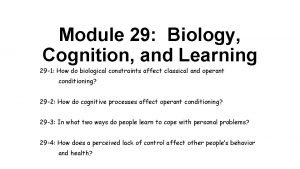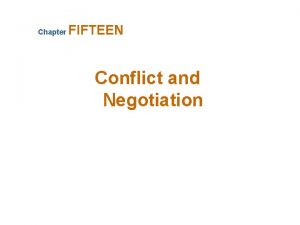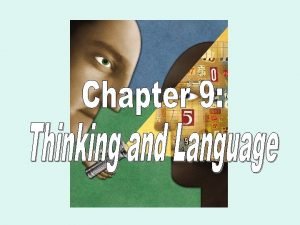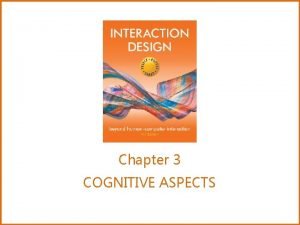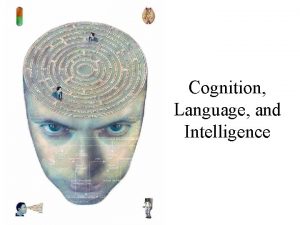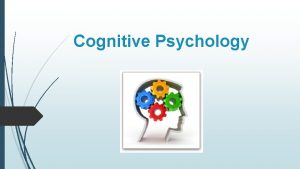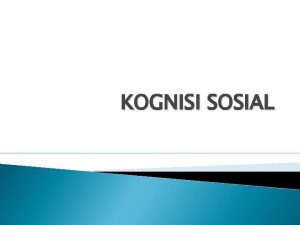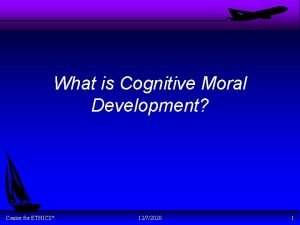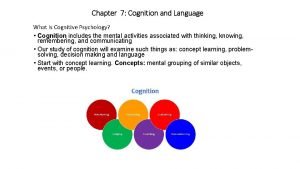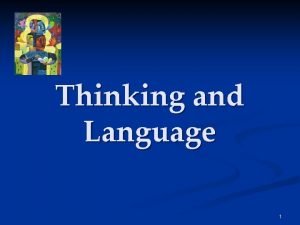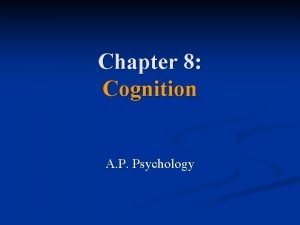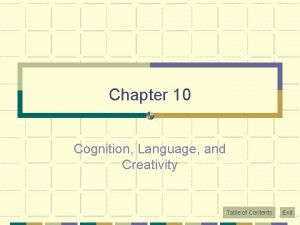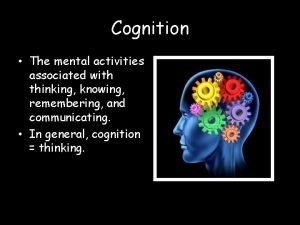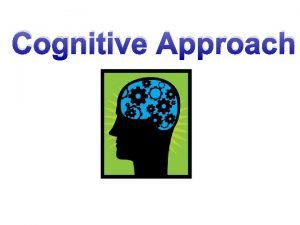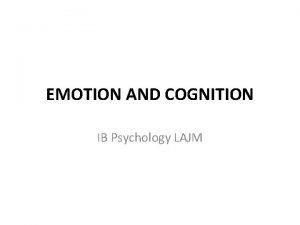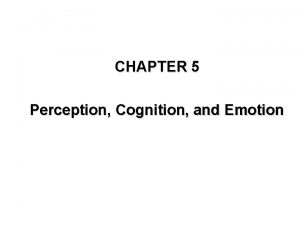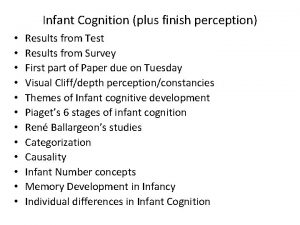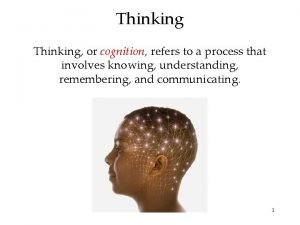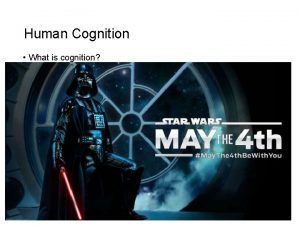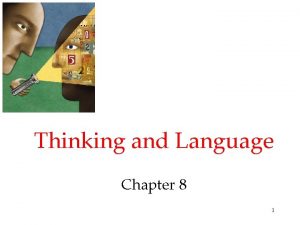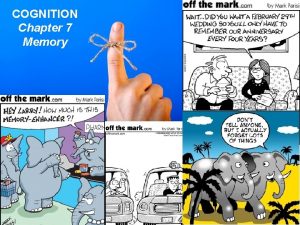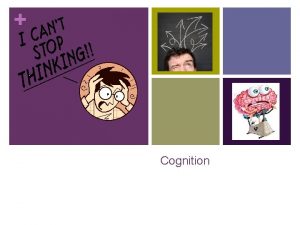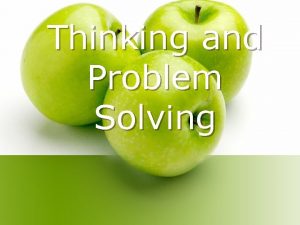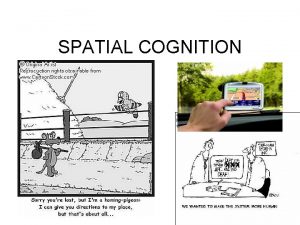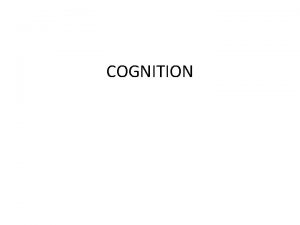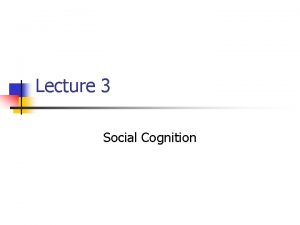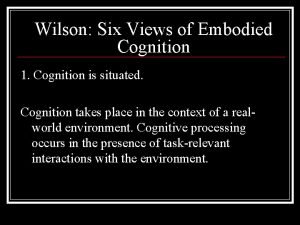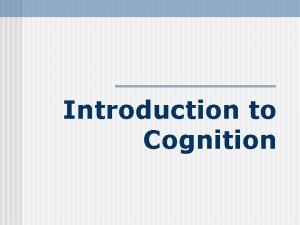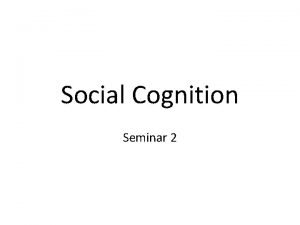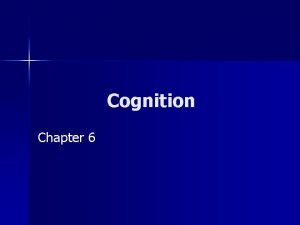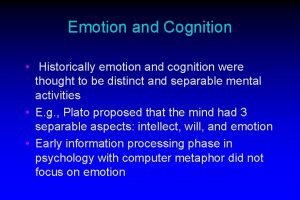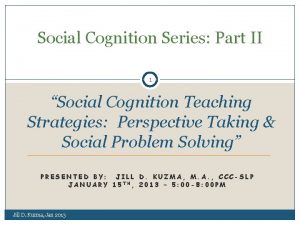1 e Cognition Overview e Cognition is a






















- Slides: 22

1. e. Cognition Overview

e. Cognition is a knowledge utilisation platform based on Active Knowledge Network technology e. Cognition covers the full knowledge cycle – capture, marshalling and deployment Combines active modeling, data mining, simulation, analysis and visualisation 1. e. Cognition Overview 1

e. Cognition’s Goal e. Cognition is intended for the rapid deployment of a wide variety of active knowledge in complex and dynamic environments 1. e. Cognition Overview 2

e. Cognition Concepts • Realised Structure • Active • Long Lived • Undirected • Self modifiable • Structural Backtrack • Complex messages • Autonomous Objects 1. e. Cognition Overview 3

Realised Structure A structure, unlike a sequence, doesn’t have an implicit beginning or end - it just is. This physical reality gives it the potential for extensibility and connectability. Lego is an example of extensible structure composed of simple elements. If we wish to model the world around us, it seems reasonable to use a realised structure to do so, as long as we can change it easily as the world changes. 1. e. Cognition Overview 4

Active A passive structure needs something else to “read” it, and this something else must be capable of understanding what it reads - it must be more complex than what it reads and be able to subsume what is read into itself. An active structure needs nothing else to understand it. We are surrounded by active structures - the light switch on the wall is one, we are another - the message is carried in the structure, not by something outside it. 1. e. Cognition Overview 5

Long Lived A structure which is being constantly recreated from a text file or a database or being implemented on a stack does not have the opportunity to learn complex new behaviour. A realised structure which survives local change - which accepts change by others or uses local change on itself to change its own behaviour - can continue to adapt to its environment. 1. e. Cognition Overview 6

Undirected If a structure is directed, its goals are already fixed and new connections can have little effect on its topology. A structure in which direction of information flow is not predetermined can be used for many purposes not predicted when it was constructed. A new connection can change its topology, and hence its behaviour, drastically. A telephone network is an example of a realised, undirected structure - anyone can call anyone else using its connections and a call can lead to a new connection. 1. e. Cognition Overview 7

Self Modifiable An undirected active structure which could only have its connections changed by human intervention would be of limited use. A = SUM(List) as a structural description means the system must wait to find out how many elements the List has before connecting to them. Self modification ranges from the trivial, connection of links to objects delivered to an operator, to the construction of associations dependent on activity and the existing structure, so the structure grows under its own cognisance. 1. e. Cognition Overview 8

Backtrackable A self modifiable structure needs to undo any modification that proved unproductive, so it can improve its operation by trial and error. A realised structure has much more to undo than a virtual structure that consists only of variables on a stack. Change Image Storage is used to store any change, and allows for structural backtrack after building “castles in the air”. 1. e. Cognition Overview 9

Complex Messages Simple messages limit the complexity of interactions, or require very many parallel paths. Complex messages, up to and including structural descriptions, allow for the transmission of complex behaviour along relatively few paths. For transmission to remote structures, only complex messages are feasible. Such messages assume complexity of structure at either end of the transmission path. 1. e. Cognition Overview 10

Unscripted Interactions It requires relatively few operators in an undirected structure able to pass complex messages among themselves before the possibility of scripting their behaviour, of preordaining it, becomes impossible. While this is good in terms of modelling the complexity of the world, it is useless if we cannot understand what is the cause of the behaviour. It becomes essential that the behaviour of each operator, in response to input states, can be validated and predicted - the more atomic the operator, the more predictable the result. 1. e. Cognition Overview 11

Autonomous Objects The downside of a realised network is that there is only one copy. Modelling the interaction of several similar objects requires that there be several copies. This is handled by creating subnet invocations - linkable, long lived objects which maintain their own states but which share the logical structure which drives each of them. 1. e. Cognition Overview 12

Active Knowledge Networks Put all these concepts together and we get e. Cognition - a system for Knowledge Capture, Marshalling and Deployment 1. e. Cognition Overview 13

Modelling Environment • Knowledge entry • Analysis and visualisation • Manipulation tools 1. e. Cognition Overview 14

Knowledge Entry Logic Editor Miner Drawing Editor 1. e. Cognition Overview 15

Logic Editor - Used to enter declarative knowledge in textual form. The text is immediately transformed into active model structure. 1. e. Cognition Overview

Miner One of the shortcomings of existing data mining technologies is that in order to use the findings, the user needs to understand them. The reason is that the technologies used for mining are different to those used in operational systems. A human needs to bridge the gap. With e. Cognition, the same technology is used for both tasks. The Miner actually morphs newly found correlations in the data into active component of the operational system. This is one of the reasons behind e. Cognition’s flexibility and responsiveness. Also, unlike other systems, the Mined knowledge is seamlessly embedded with domain knowledge, and can be used for multi level inference. 1. e. Cognition Overview 17

Analysis and Visualization Network Display Stochastic Editor Variable Directory 1. e. Cognition Overview 18

Stochastic Editor The user can • visualize and manipulate distributions and Ndimensional relations. • apply constraints to variables and observe the impact on other variables • construct ad hoc distribution and relation operators 1. e. Cognition Overview 19

Network Display The user can: • track the network • observe the values in network components • track inconsistencies • follow propagation paths of values • delete network structures 1. e. Cognition Overview 20

Interfaces Generic Interfaces • Structural debugger • Script editor • Simulator • Time Series Analyser 1. e. Cognition Overview 21
 Module 29 biology cognition and learning
Module 29 biology cognition and learning Unit 7 cognition ap psychology
Unit 7 cognition ap psychology Cognition and personalization
Cognition and personalization Chapter 7 cognition thinking intelligence and language
Chapter 7 cognition thinking intelligence and language Belief bias ap psychology
Belief bias ap psychology Belief perseverance
Belief perseverance What is cognition
What is cognition Does language reflect intelligence
Does language reflect intelligence What is cognition
What is cognition Konsep ketersediaan heuristik
Konsep ketersediaan heuristik Moral cognition
Moral cognition Means end analysis psychology example
Means end analysis psychology example Language
Language Embodied cognition ap psychology
Embodied cognition ap psychology Cognition mse
Cognition mse Cognition definition
Cognition definition The mental activities associated with thinking
The mental activities associated with thinking Cognition definition
Cognition definition Teacup ib psychology
Teacup ib psychology Objectives of perception
Objectives of perception Cognition plus
Cognition plus Mental grouping of similar objects
Mental grouping of similar objects Cognition mse
Cognition mse
